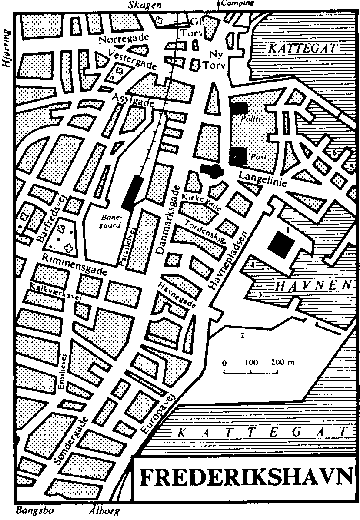





|
Historical Background
At the time of Christian Sorensen Fugl's birth in about 1779, England and America were engaged in the Revolutionary War. Denmark joined a League of Armed Neutrality for the protection of shipping against the warships and privateers. "This small agriculturally productive country found its foreign markets better than ever and a brief mercantile boom swept Denmark." 14
The original name of Fladstrand means literally "flat beach." The name was changed to Frederikshavn (which means literally "Frederik's harbor") in 1818 when it received its municipal charter.15 The king of Denmark at the time was Frederick VI. He was the son of Christian VII and Queen Caroline Mathilde. He was born in 1768. His father became insane and his mother was divorced, exiled, and then died at age 24. Frederick was four when she was carried away. Crown Prince Frederick, his father mad and his mother dead, initiated a happy period of social and fiscal reform. He instituted reform on behalf of the peasants, abolishing all vestiges of serfdom. The Stravnsband had provided that all Danish farmers' sons from their 14th to 36th year should be bound as serfs to the estate on which they were born. The Stravnsband was abolished in 1788 and the peasant was allotted his own plot of land. Nearly half the Danish peasants became freeholders.16
Frederick became king in 1808. Laws were passed to provide for the welfare of paupers, and Denmark became the first European country to denounce the owning of slaves. Frederick was the first truly Danish king for many centuries. "He would speak only Danish at court, abandoning German, which had been the official language for hundreds of years."17
Frederikshavn (formerly called Fladstrand)
Frederikshavn is the most important fishing port of northern Jutland. It is located in the north-eastern tip of Jutland. The town is at sea level. Today it has a population of about 35,000. It is one of Denmark's three principal naval bases. The reason Christian was taken to Aalborg to be apprenticed was that "in 1769 Ålborg was the only town besides the capital (Copenhagen) with a population of more than 4000. It has always dominated the commerical activities of northern Jutland." 18
A description of present day Frederikshavn states: "In the middle of the town, by the harbour, stands the old Powder Tower (Krundttårnet, 1688) which now houses a collection of weapons dating from 1600 onward. To the north of the fishing harbour is the oldest part of the town, Fiskerklyngen, with many well preserved 17th Century houses. The manor house of Bangsbo, 1750, now a museum with models of ships, figureheads and a collection of more than 1000 stones with carvings or inscriptions, the oldest dating from pre-historic times." 19
 |
Features of interest on the map: 20
1 Museum (powder magazine) 2 Tourist office 3 Boats to Sweden 4 Boats to Laeso 5 Boats to the Hirsholm isle 6 Fish market Note: Fladstrand Kirke and graveyard are at the top of the map near the word Skagen where there is a cross drawn. Fiskerklyngen is just to the east of that by the Kattegat Bay. |
Nagel describes Frederikshavn thus: "To the north are the old Tordenskjold House and the fishermen's quarter, Fiskerklyngen, with the seamen's church and churchyard.To the south of the town is the manor-house of Bangsbo (1570), once the home of the novelist Herman Bang, now a museum devoted to the history of fishing and shipping and the Danish Resistance. 4 km southwest on the road to Brønderslev is the Cloostårn, a high lookout tower affording fine views." 21